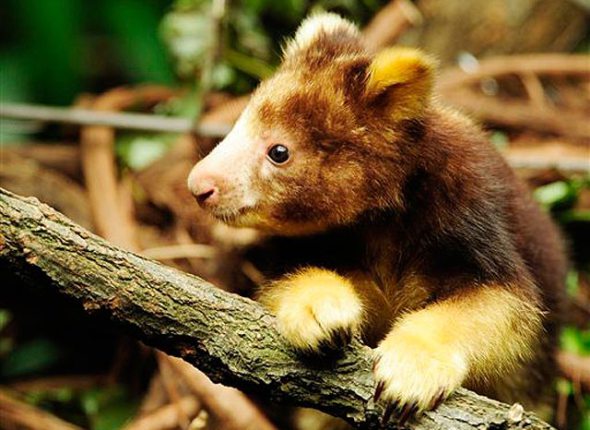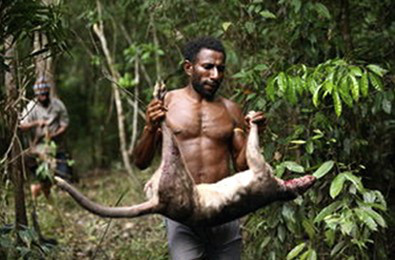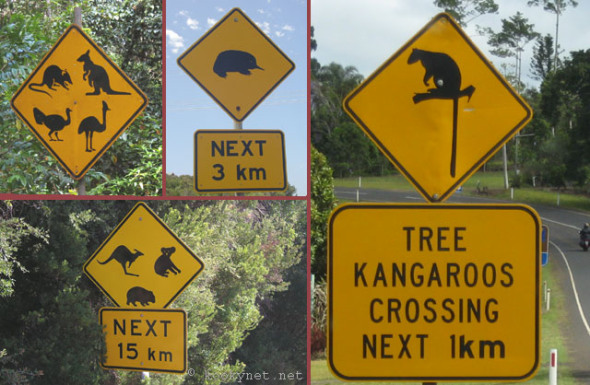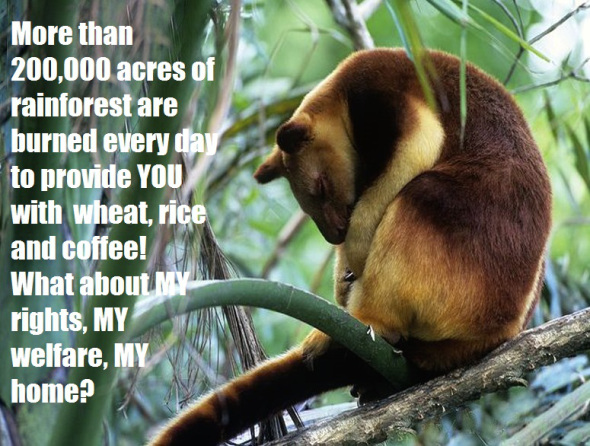Tree Kangaroos Facing Extinction.
History:
The Tree-kangaroos are a genus of Macropodidae marsupials of the genus Dendrolagus adapted for arboreal locomotion. They inhabit the tropical rainforests of New Guinea, far northeastern Queensland and some of the islands in the region. Most Tree-Kangaroos are considered threatened due to hunting and habitat destruction. The Tree-Kangaroo is the only true arboreal member of the Kangaroo family. Hunting and habitat fragmentation poses the highest risk to all fourteen species of Tree Kangaroo. Lumber companies also pose a danger to these adorable marsupials of which they hunt either for their alleged succulent meat or fur trade which is quite limited.
Hunting:
Tree Kangaroos are one of Australia’s most threatened macropodidae marsupials of the genus dendrolagus. There are some fourteen species of Tree Kangaroo and most are classified as endangered or vulnerable while other species of Tree Kangaroo slowly edging closer to threatened status.
Bennett’s Tree Kangaroo is listed as endangered, Doria’s Tree Kangaroo vulnerable, Goodfellow’s Tree Kangaroo is listed as endangered, Grizzled Tree Kangaroo vulnerable, Lumholtz’s Tree Kangaroo is known as least concern, Huon Tree Kangaroo endangered
Wondiwoi Tree-kangaroo critically endangered, Dingiso listed as endangered a species of Indonesian native tree kangaroo, Ifola tree-kangaroo endangered native to papa new guinea. The Golden-mantled Tree Kangaroo critically endangered, Scott’s Tree-kangaroo is listed as endangered, Lowlands Tree Kangaroo listed as vulnerable, Seri’s Tree Kangaroo listed as vulnerable and finally the Vogelkop Tree Kangaroo is listed as vulnerable.
Most species of Tree Kangaroo are endemic to Australia while other species are native to Papa New Guinea and Indonesia. Tree Kangaroos in Australia face many threats of which habitat fragmentation is the largest threat known to these quite adorable macropodidae marsupials. Hunting with dogs was said to be no longer an issue with regards to these amazing tree dwelling species of macropods. Tree Kangaroos have adapted to a life in trees so while there habitat becomes less they become threatened by other predators and dogs of which they would normally be able to hide from within the high canopies of trees.
Tree Kangaroos have been hunted for food by indigenous communities across their range for many hundreds of years. For a number of species, this factor alone has contributed to a sharp decline in population numbers. While few species populations of Tree Kangaroo are stable and not declining the majority of others are sadly on the decline. The Wondiwoi tree kangaroo is critically endangered (possibly extinct) there are said t be no fewer than fifty individuals remaining in the wild as we know it.
Two species of Tree Kangaroo are no longer hunted. Scott’s Tree Kangaroo (known locally as the ‘tenkile’) and The Golden-mantled Tree Kangaroo was almost hunted into extinction however the very people that once hunted the species for food now no longer hunt them. Torricelli Mountain Ranges in the north-west of Papua New Guinea did host some fourteen hunting communities. These hunting communities have since now signed a hunting moratorium or a pledge as we know it not to hunt both species.
Conservation Education have achieved major success within the region of Papa New Guinea and instead of hunting Tree Kangaroos into extinction the Conservation Organisation has since established rabbit farms that the locals have implemented into their diets instead of Tree Kangaroos. This form of conservation is known as “sustainable utilization” of natural sources instead of threatened. While rabbits can easily be farmed and bred for food it is helping to preserve the Tenkile and The Golden-mantled Tree Kangaroo. Some people may disagree while many others will agree this is indeed a much safer alternative. Failing this the Tenkile and The Golden-mantled Tree Kangaroo would have gone extinct long ago.
Picture below depicts Tree Kangaroo Hunters.
Unfortunately while some of the Papa New Guinea species of Tree Kangaroo may be safe for now many other species within “Australasia” are not so safe.
Unlike other Kangaroos, Goodfellow’s Tree Kangaroos like to stay in the treetops rather than hopping around on the ground. They choose to live in the treetops to protect themselves from enemies on the ground. The New Guinea Island used to be rich in nature but as it became the major exporter of lumbers and minerals, the forests were destroyed by the human. The more and more safe places to live for Goodfellow’s Tree Kangaroos are now disappearing. Sadly this is a common threat now to many forest dwelling animals that rely on the forests to survive. Humans want for more wood products and paper for example are decreasing habitat of the Tree Kangaroo all over Australasia.
To make the matters worse, roads have been extended to the middle of a forest. It has made Goodfellow’s Tree Kangaroos an easy prey for hunters who go after their meat. They are usually active in the morning and evening but those who live in the area where there are many people have become nocturnal. Once they chose to live in the treetops to protect themselves from the enemies; maybe now they have changed their lifestyle for fear of human, their new enemies.
Matschie’s Tree Kangaroos pictured above are primarily hunted by the natives of Papua New Guinea. They are traditionally hunted by natives with dingos, which sniff the Tree Kangaroos out and grab them from the trees. Doing it this way allows many of them to escape. However, the introduction of guns to the island has placed their future in jeopardy. They are hunted for their succulent meat. Matschie’s Tree Kangaroos are endangered, with only 1400 left in the wild. Breeding programs in zoos worldwide are helping to conserve this species. So all in all those that believe zoos are very bad places must remember that without zoos we cannot breed and preserve some of worlds most endangered species on the planet.
Logging and timber production:
Does felling endanger tree dwelling wildlife such as the Tree Kangaroo and Primates?
logging and timber production have placed the most of the fourteen species of Tree Kangaroo in dire danger. Logging often destroys natural habitats, resulting in the loss of biodiversity and sometimes leading to the local, and possibly global, extinction of species. Although estimates of the rates of loss vary, few deny the reality of the current losses of both flora and fauna. While hunting in some 14 villages in Papa New Guinea may have preserved two species of Tree Kangaroo the logging industry valued at billions of US dollars will never end unless environmental organisations and governments come together to now propagate more sustainable programs that will not harm our already critically endangered fauna. In this case the Tree Kangaroos of Australasia.
Logging companies in Papa New Guinea also have a detrimental affect to human populations thus placing wildlife in danger furthermore. The documentary video below aimed more at “human problems” shows the devastating effect that logging is causing to our critically endangered ecosystem.
According to a joint report by the Worldwide Fund for Nature and the Sarawak Forest Department, “Logging causes immediate forest disturbances, long-term habitat changes (e.g. damage to food trees and salt-licks), increased hunting by timber company workers and availability of logging roads as hunting routes. The destruction of wildlife from habitat loss must be recognized to be on an enormous scale”. In Central Africa, the opening-up of the forest by logging facilitates the illegal hunting of wildlife, including protected species such as primates, and is leading to a decline in wildlife populations. So logging and hunting is not just confined to one area of the globe. Deforestation is a primary concern that places all species of forest and tree dwelling animals in danger.
Even so called selective logging severely affects the complex and rich biodiversity of forests through excessive damage to residual stands, destruction of other plant and tree species and the creaming-off of species which are the most valuable for timber. An FAO study in Malaysia has shown that as much as 50% of the standing forest may be damaged and the surface soil destroyed when up to 30% of the ground surface is exposed. During silvicultural treatment in logging operations in Sarawak, so-called uneconomic forest species are deliberately poisoned. This reduces the complexity and species diversity of the tropical forests to only 10% of the original condition, resulting in the systematic elimination of tree genetic resources and contamination of the environment. According to the IUCN the most frequently recorded of all threats to globally endangered tree species is ‘felling’.
While palm oil production within Indonesia, Malaysia and Africa places many species of forest dwelling animals in danger of extinction, coffee, rice and what production are threatening the Tree Kangaroo species quite significantly. However there are ways in which we can help to stop “unsustainable agricultural practices” that are endangering our critically endangered fauna and flora.
Think before you shop:
There are now hundreds of thousands of companies across the globe that are helping the environment by sourcing their own “local” brands of foods. Local sourcing not only helps local communities and increases employment it also helps to reduce unsustainable agricultural practices across the globe thus reducing habitat fragmentation, pollution, indiscriminate hunting and poaching plus cuts green house gas emissions too. Least forgetting when one sources their products locally they help to reduce trade slavery that is rampant within still developing worlds.
International Animal Rescue Foundation, Say No To Dog Meat and Environmental News and Media supports (FAIR TRADE) and (LOCALLY SOURCED) that not only helps local and international farming communities but also our environment. You can find Fair Trade AND Locally Sourced products quite easily now. Just look for the Fair Trade and Locally Sourced logo on many products that you purchase from produce to wine and much more. If you are unsure please ask your hyper-market store manager.
Locally Sourced is a great initiative that helps many species of animals. We ourselves would rather purchase coffee, wheat and rice that has been grown within our own countries instead of habitats that are destroying many species of flora and fauna. Think about it. Greener and safer is always the best option.
Kill your Speed not our Wildlife:
With large scale deforestation rampant in Australia, Indonesia and Papa New Guinea this has led to many Tree Kangaroos becoming a cropper hit by cars or large road trains they face little chance of survival or recovery. Lumholtz’s Tree Kangaroos here on the Atherton Tableland, live in highly fragmented patches of rainforest and are frequently hit by cars or attacked by domestic dogs.
Lumholtz’s Tree Kangaroo and Bennett’s Tree Kangaroo are the only two species of Tree Kangaroo that are native to Australia. Deforestation and agricultural practices has led to roads opening up of which has seen many of them sadly killed. Research suggests Lumholtz’s Tree-Kangaroos prefer forests growing on the Tableland’s rich basalt soils. As this is also the best soil for farming, much of the Tree-Kangaroo’s habitat has been cleared for farms. They have fortunately been able to survive in the strips along creeks and in areas that are too rocky for farming. However, they mostly live on private land, which is unprotected by World Heritage and National Parks status.
This extensive clearing of lowland rainforest greatly reduced the range of Lumholtz’s Tree-Kangaroo. Highland forest logging is further reducing the range, but it is present in reasonable numbers in several national parks and reserves. When on the ground, they are vulnerable not only to dogs, but also to vehicles. Of 27 dead Tree-Kangaroos examined in the Atherton Tablelands from 1992 to 1994, 11 had been hit by cars, six had been killed by dogs, four by parasites and the others by other causes.
As a result of the growing concern for the Tree-Kangaroo’s future, the Tree Kangaroo and Mammal Group was formed. The Group meets at 7.30pm every first Thursday of the month at the Malanda Hotel. Annual membership is $10. The Tree Kangaroo and Mammal Group is happy to have received a Natural Heritage Trust grant to examine different rainforest fragments as possible Tree-Kangaroo habitat.
While humans continue demanding and reproducing will our species of wildlife ever be safe? At some 7.8 billion humans and growing demand for agricultural products, meat, wood, paper and more will sadly reduce more forest land thus leading to the extinction of planets non-human species.
We must decrease our usage of natural resources. End off.
Thank you for reading this brief insight into Tree Kangaroos.
J. Williamson PhD. Ba. EnVStu
Environmentalist and Botanist
Chief Registrar of International Animal Rescue Foundation Europe.
Hundreds of ANIMALS and PLANTS killed off everyday for YOU.
WHERE IS THE JUSTICE IN THAT?









